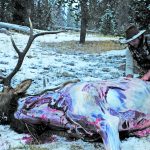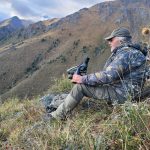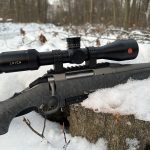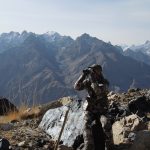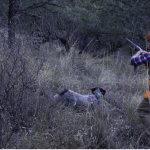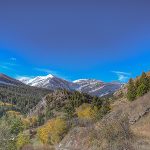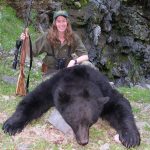A few items of gear you should never be without in the field.
Photo above: Wilderness hunting can present danger and hardship along with the thrill and adventure. It pays to prepare for both.
The wilderness offers adventure, solitude, and good hunting, but only to those who earn them. If you venture afield unprepared you may get hurt or killed–not because the wilderness is cruel, but simply because it is indifferent to those who don’t respect it.
Years ago I made a hurried dusk-time stalk on a bunch of elk feeding near the top edge of a steep, aspen-covered mountainside. Recurve in hand, I followed them into the timber. Hope of a shot opportunity lured me onward until shooting light was gone. By this time I was deep into the timber, buried in a sea of deadfall logs and tree trunks. As I turned my boots down the steep mountainside toward camp I realized I had a problem–the night was black as hell’s kitchen, and I had no flashlight.
Stumbling, falling, and crawling through deadfall, I tried to escape the timber. Blinded by darkness, I slipped on a damp log where a small spring seeped from the mountainside. Plunging forward, I fell into the blackness. My leg wedged between logs and the bone bent and creaked as I grunted in agony and expected it to snap. Thankfully I was young and flexible, and my bone held. Swearing never to go afield again without a light, I crawled slowly down the mountainside and out of the thicket.
Since that time, I’ve developed a short list of gear that I try to never go afield without. I divide my survival gear into three categories: stuff I keep on my person at all times, items I carry in my backpack, and gear that waits at camp against a time of need. Let’s take a look at each category.
Pocket and Belt Gear
There are a few items that live in my pockets anytime I venture afield. First is a multitool containing a sharp blade, needle-nose pliers, Phillips screwdriver, standard and tiny flathead screwdrivers, and a can/bottle opener. Second is a compact but bright headlamp. Third is a simple cigarette lighter. In certain circumstances I’ll keep an inReach device and bear protection on my person as well.
I use the multitool most. With the pliers I can twist or cut wire, untie frozen knots, and pull thorns and cactus spines from places they don’t belong. The blade acts as a backup should I loose my primary skinning and quartering knife, and I use it regularly to cut string, whittle tent pegs, and so on. With the screwdrivers I can make simple repairs on gear and even firearms, and I use the tiny flathead to adjust my spectacles and bore holes in wood or leather. Some multitools sport saw blades, scissors or files, and these tools can come in handy in the backcountry. However, don’t carry a heavy, bulky multitool unit with so many appurtenances that you can repair an airplane in the field with it. Every ounce counts when you’re climbing rugged, high-elevation territory every day.
My headlamp gets a lot of use as well, lighting my way before dawn, helping me sort gear in the tent at night, and illuminating my work as I skin and quarter game after darkness falls. For backcountry work you need a tough, compact headlamp with buttons that don’t accidentally activate. This is more important that you might think–the first time you pull your light out to process an elk after dark and the battery is dead from illuminating your pocket all day, you will recognize that. The best remedy is a button that locks, making it impossible to activate your light until you unlock the button. Finally, use a headlamp that provides a variety of beam and brightness intensities. I like a light that can alternately use a mini-USB charger or triple-A batteries. Check out the Revolt 350 made by Black Diamond; it’s built right for the backcountry hunter and sports all the features mentioned above.
For a lighter I like a simple convenience-store BIC or similar, so long as it’s not one of the cheap models. Save up and buy the $2.95 lighter, and leave the 79-cent model on the shelf. I do like to test each lighter to make sure it provides an enthusiastic flame, especially when I’m headed into high-elevation territory. Elevation robs everything of oxygen, and flame intensity will reduce the higher you climb. Carry the lighter in your pocket and make sure the flame mechanism stays clean and free of lint.
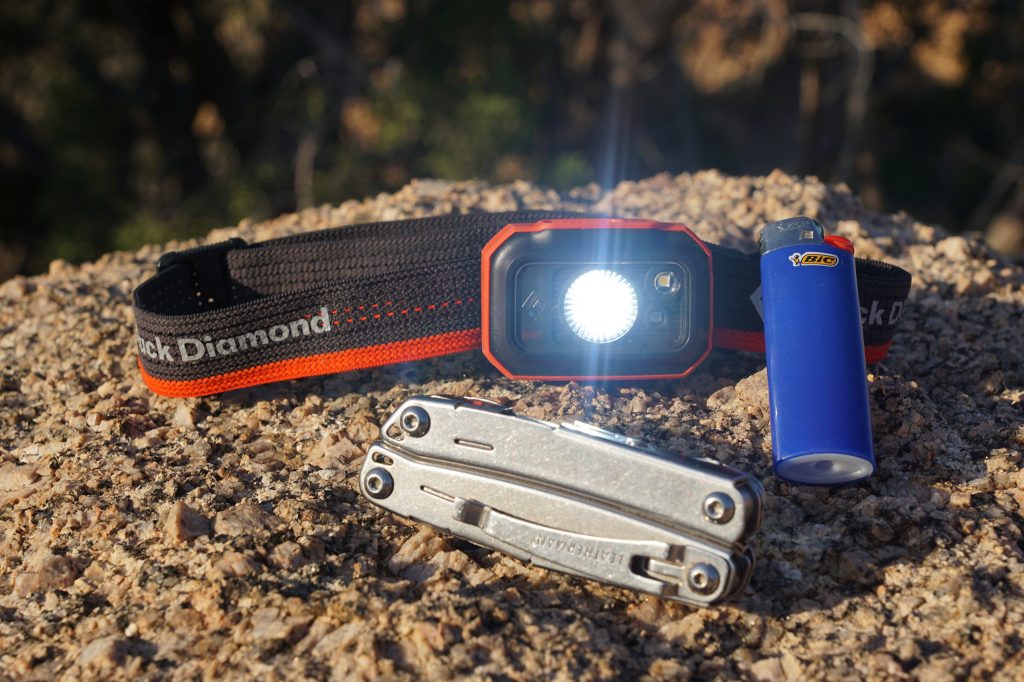
A fourth on-the-person item becomes paramount when hunting territory where grizzly or brown bears live. That item is, predictably, some sort of bear deterrent. This can be bear spray or a handgun, or both. Personally, if I had to choose only one it would be a handgun, mostly because I have more faith in my ability to stop a bear with a gun than with spray. My preferred handgun for bear protection is a S&W M&P 10mm, outfitted with a Streamlight TLR 8 with a green laser for nighttime illumination, and shooting 200-grain Federal Premium Solid Core ammunition. This combination shoots intuitively and hits hard while providing a lot of rounds on-tap. I mount the Streamlight as soon as dusk falls, which provides me with 500 lumens of brightness and an easy-to-see point of aim. When I’m in bear country, this setup remains on my person at all times.
Lastly, in wilderness territory I like to carry an inReach device. This enables me to communicate with my hunting partner or family when cell service is absent, and provides SOS capability in case of real disaster.
In My Pack
There are a few additional survival items I like to have readily available, but don’t keep them directly on my person. In critical scenarios they can save my hunt, or even my life. They include some sort of water purification system, a package of QuikClot, and a roll of Leukotape.
For water purification I usually carry a Lifestraw or iodine tablets. Both are superlight and relatively compact. The iodine tablets in particular cost me very little room and weight, but they are slow–after treating water you must wait thirty minutes before consuming it. That thirty minutes can be agonizing if you’re truly thirsty, believe me. The LifeStraw is faster–you can suck water directly from any decent source–but is more work and less compact. Don’t plan on using either for your main water supply; they are just backup for emergency scenarios.
QuikClot is a substance that when correctly applied to a dangerous hemorrhaging wound will rapidly form a life-saving clot. I’ve never needed to use mine, and Lord willing, never will. But I spend a lot of time in the backcountry, and if one of my companions or I ever suffers a bear mauling or a bad knife wound, I’ll be prepared.
Bad blisters can put an end to a hard-core hunt, so I always go prepared to stop a blister before it happens. As soon as you feel a hot spot forming on your foot, peel away your socks, let the skin air dry well, and then apply a layer of Leukotape directly to the irritated skin. Make the patch a bit larger than the problem area, and if it’s on a toe go ahead and wrap the tape–not tightly–all the way around. It’ll stay firmly in place, providing protection against further abrasion and damage. Add a second layer if necessary.
At Camp
These last couple items live at camp, in the case of a horsepack trip or float trip, or in the truck if I’m backpack hunting. They are mostly used to put things back together after some sort of snafu.
Suture kit: I use this on a surprisingly common basis, mostly on hunters who have cut themselves and horses that have been hurt in a wreck. Just recently a friend told me about a ferocious cut he gave himself while on a float hunt in Alaska for caribou. For days afterward he fought to keep the wound clean and the bleeding at bay. Had he possessed a simple suture kit, thirty minutes of sewing would have eliminated all that hassle and agony. You’ll want some #4 suture thread with needle, small forceps, alcohol wipes, and antibiotic powder or ointment in your kit. If possible, sew a wound soon after it is inflicted–the sewing will hurt less. If you have horses along, add livestock suture to your kit.
Wire: I keep wire in my camp kit to use kind of like suture for gear. I’ve repaired backpack buckles, stitched heavy leather, fixed rifle sling swivels, and repaired a plethora of other gear with simple wire. Keep a little roll of small-diameter tie-wire (available at any farm supply store) in camp. You’ll appreciate having it, I promise.
Finally, no list of survival gear is complete without a discussion of common sense. Indeed, your wits are the most important survival tool you will ever possess. Take the time to study, learn, and train to meet challenging situations in the wilderness. Learn to build a fire in cold, damp conditions, and practice navigating in the dark. Use your inReach until it’s second nature. Learn the surgeon’s knot and sew a few orange peels back together. Train to keep calm under pressure and make solid, common-sense decisions. When times get tough in the backcountry, you’ll be ready.


